Château Palmer launched its first back-vintage release yesterday (Thursday 24th September). Named “N-10”, this new release phenomenon is planned as an annual event henceforth, releasing each year the vintage celebrating 10 years of age.
N-10 therefore begins on an exceptional note for quality, with Palmer’s 2010 vintage (which earns a WL score of 96 – its second-highest ever). It is also worth noting that 2010 was the second vintage of Palmer to benefit from some biodynamic experimentation, ultimately leading to its full certification in 2017.
Wine Lister partner critic, Neal Martin, awarded Palmer 2010 96 points after tasting at BI Wines’ 10 years on tasting in February this year. “This is an outstanding Palmer, but it needs more time in bottle”, he notes. Wine Lister’s CEO and Founder, Ella Lister, concurs, stating, “the wood still apparent after spitting will certainly integrate more with time – because this needs lots of time”, though her overall assessment is perhaps more generous than Martin’s 96 points. She adds, “There’s a quiet, dreamy poise to this wine. [It is] enigmatic, brooding, and spellbinding”.
The last remaining ex-château stocks of Palmer 2010 entered the UK market at £293 per bottle (in-bond), making them the highest-priced recent vintage on the market. The new price of Palmer 2010 therefore sits at a 33% premium to previous remaining market availability.
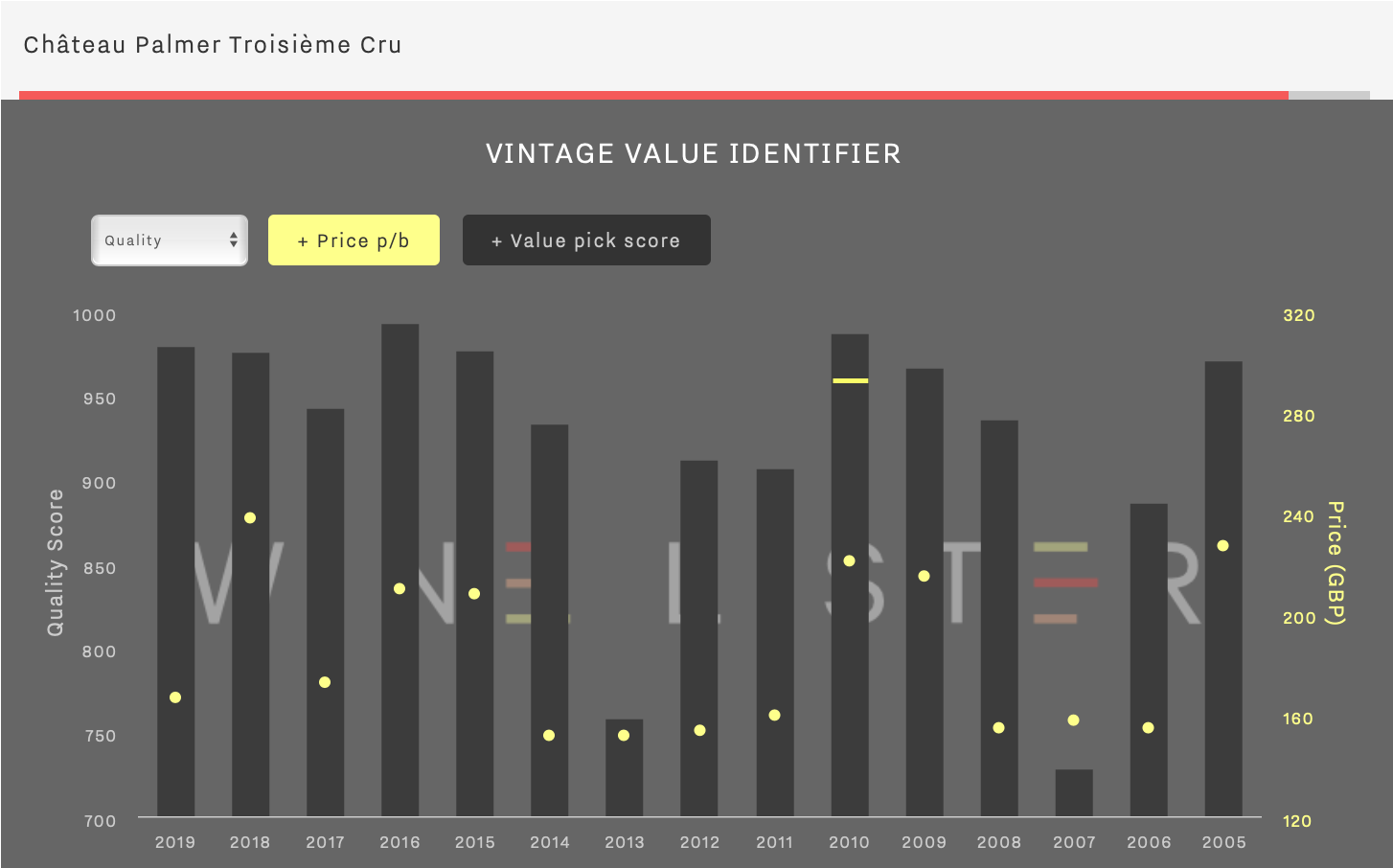
This is a bold hike up from Palmer 2010’s initial release price, however Director Thomas Duroux’s communication on production quantities and pricing as a direct result of the château’s uncompromising commitment to biodynamics and exceptional quality has prepared the market for it. The last few en primeur releases have set a solid scene for Palmer’s new strategy, and provide definitive proof that the château has outgrown the bounds of its classification.
We understand that immediate take-up for the N-10 release has been good, if not quite at the fast sell-out pace of en primeur. That is not the objective here – Duroux is confident that this ex-château stock will satisfy demand in the mid-term.
Indeed, even at its higher price, Palmer 2010 remains a Wine Lister MUST BUY.
If 2020 has given any gift at all, it would be time at home, which many have used to read more, and learn new things on topics familiar and foreign. Today’s blog helps you discover the unique stories behind some of the world’s most recognisable wines. Read on below to discover beyond the label of these notable names.
Krug – Cracking the code
Beyond its reputation as one of the most admired Champagne brands, Krug has also pioneered an industry innovation: Krug iD. Since 2011, a six-digit “identification code” has been printed on the back label of every Krug bottle. Scanning the code with a smartphone gives drinkers access to the unique story of the individual bottle, including a vintage report, as well as offering food pairing suggestions, and recommendations for its storage and serving.
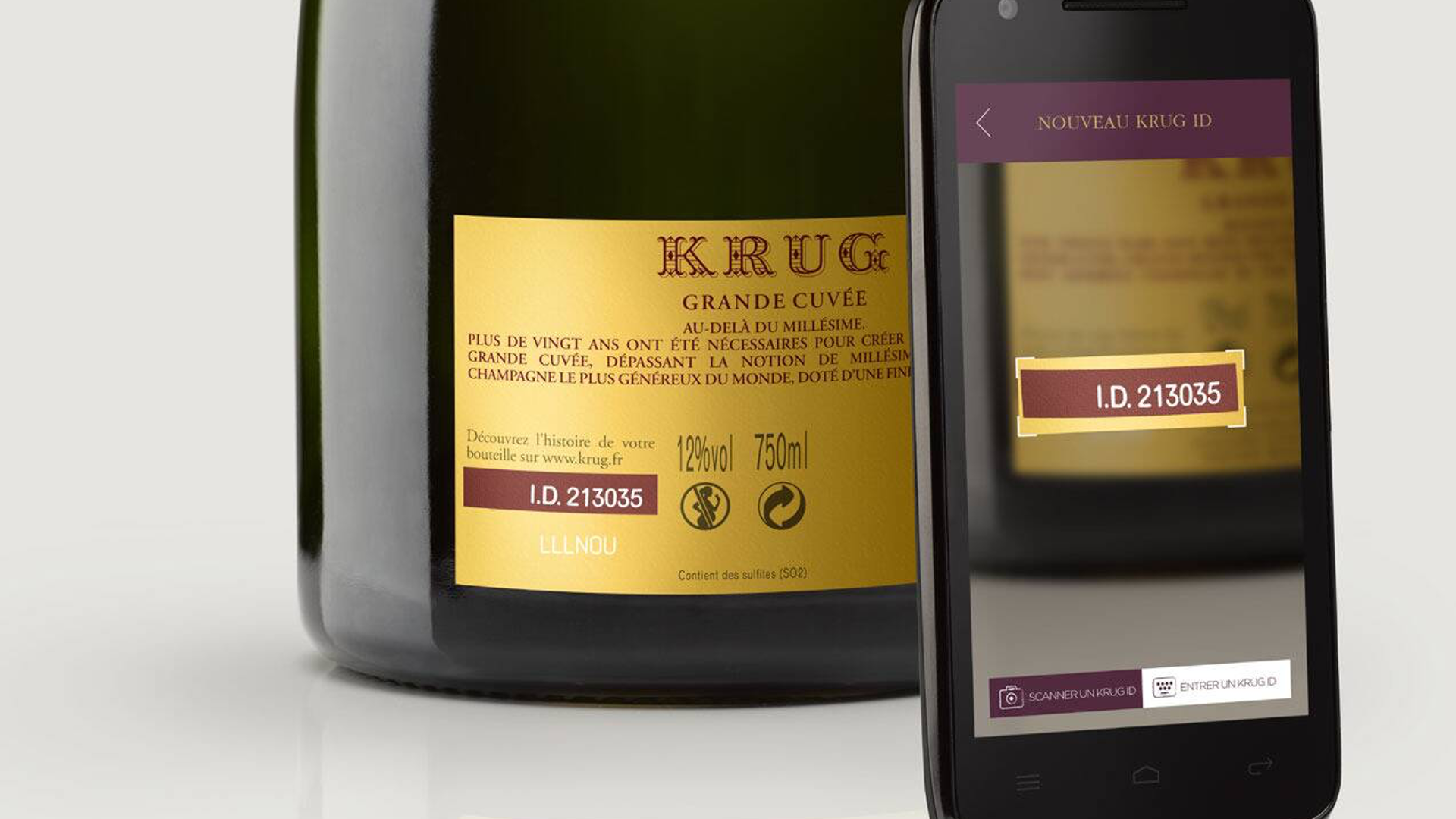 Photo credit: lvmh.com
Photo credit: lvmh.com
Aside from its technical innovation, the quality of Krug is simply undeniable. The latest NV Krug Brut Grand Cuvée (168ème Édition) achieves MUST BUY status, and receives a score of 19/20 from Wine Lister partner critic, Jancis Robinson, who notes a “remarkable acidity underpinned by great depth of flavour and beautiful balance on the finish”. It is available to purchase by the bottle from Crump, Richmond & Shaw Fine Wines for £133 (in-bond).
Cheval Blanc – Cultivation experimentation
Saint-Emilion superstar, Cheval Blanc, has illustrated significant long-term investment in its viticulture in recent years. Initiated by Managing Director, Pierre Lurton, the estate has conducted countless soil analyses, viticultural experiments, and regular phenological surveys to establish the best grape variety for each of its three different terroirs (gravel over clay, deep gravel, and sand over clay). Experiments have tested each possible variation of soil type for the Bordeaux varietals used in Cheval Blanc – 52% Cabernet Franc, 43% Merlot, and 5% Cabernet Sauvignon – to establish which combination delivers the best quality of fruit. Indeed, the château found its plot of sandy terroir to be particularly well suited to Cabernet Franc, providing a reference point for the best that can be achieved with the grape in Bordeaux.
Released en primeur in July this year, the 2019 Cheval Blanc was awarded 18 points from Jancis Robinson, who describes it as “beautifully poised on the palate with a density of fruit and silky texture of finely matted tannins. Pure, seductive and persistent”. It can be bought by the case of six for £2,400 (in-bond) from Farr Vintners.
Bond – Truth in terroir
With grapes sourced from select hillside plots across Napa Valley, Bond’s portfolio of Cabernet Sauvignon-based wines aims to reflect each wine’s specific sense of place. The estate owns five sites featuring some of the region’s best terroirs, and has dedicated its viticultural practice to preserving the best expression of its individual plots; Melbury, Pluribus, Quella, St. Eden, and Vecina.
The fruit from each site is vinified separately, while winemaking procedures are kept the same across all of the Bond wines in order to honour terroir differences. The Vecina vineyard, for instance, sits on volcanic soil at between 221 and 330 feet above sea level, causing a thermal amplitude of cool nights and hot afternoons, which renders its wines complex and layered, with concentrated tannins. The 2015 Bond Vecina was awarded 97 points from Wine Lister partner critic, Antonio Galloni (Vinous), who indeed describes it as “super-expressive. A big, dense wine, the 2015 possesses stunning richness and dimension”. It is available by the bottle for £443 (in-bond) from Fine+Rare Wines.
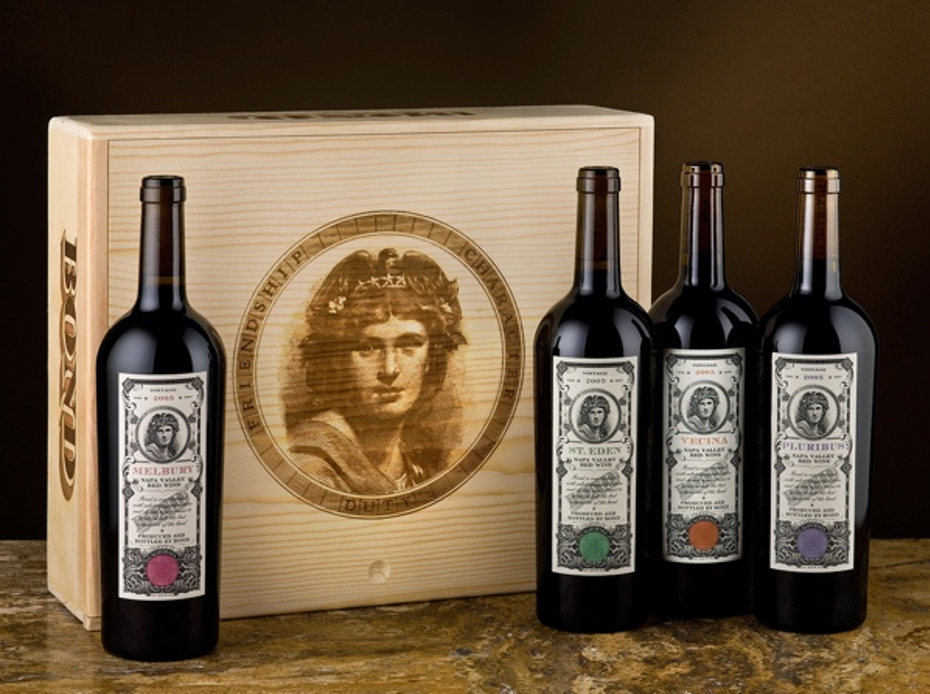 A line-up of Bond wines, that communicate the differences in the estate’s Napa Valley sites.
A line-up of Bond wines, that communicate the differences in the estate’s Napa Valley sites.
Ornellaia – An artist’s interpretation
Outside its global renown as a reference for quality in Tuscany, Ornellaia also stands out for its own special label tradition. Established in 2006, the estate’s annual artist program, Vendemmia d’Artista, commissions a new artist each year for the creation of the limited-edition label, inspired by a single word chosen by winemaker, Axel Heinz, to capture the essence of the new vintage. The latest release (2017) was named “Solare” due to the especially hot growing season, in which both the Cabernet Sauvignon and Cabernet Franc grapes were harvested as early as August for the first time in history. This inspired contemporary artist, Tomás Saraceno’s label design (below).
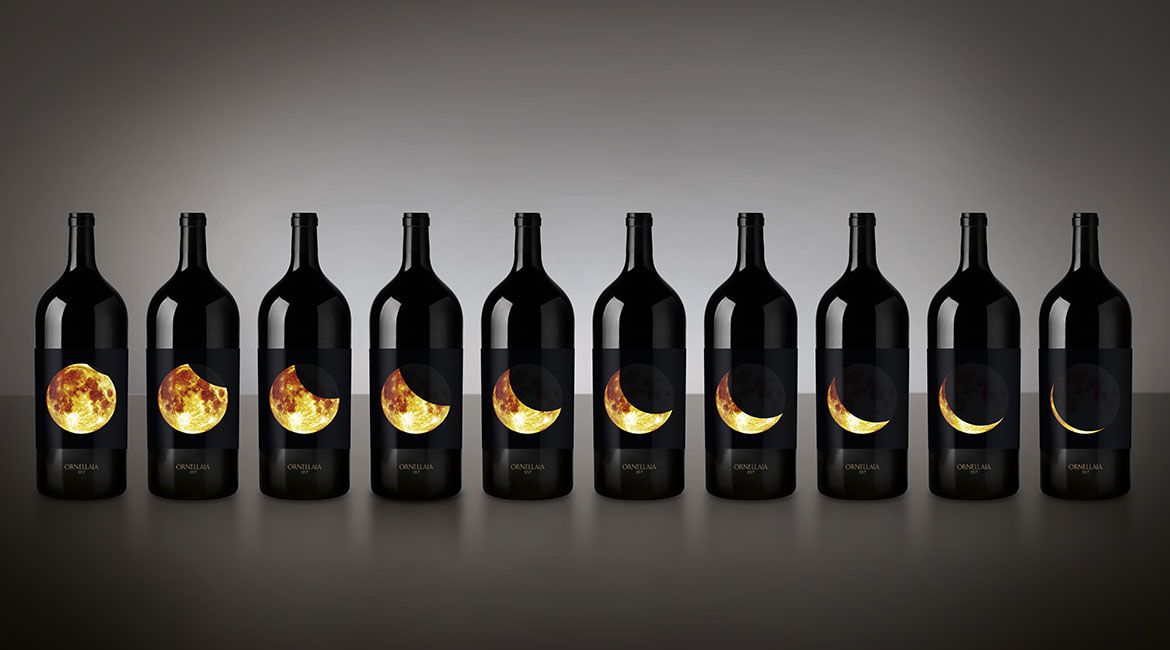 Photo credit: ornellaia.com
Photo credit: ornellaia.com
Awarding the Ornellaia 2017 97 points, Wine Lister partner critic, Antonio Galloni describes it as “sumptuous and racy, as Ornellaias from warmer years tend to be, but it is not at all heavy or overdone. In a word: superb!”. The vintage can be bought by the case of six from Justerini & Brooks for £765 (in-bond).
The four above-mentioned wineries provide just a small handful of innovative and engaging examples of how to make a wine stand out from the crowd. Wine Lister has launched a dedicated PR and communications service in order to help more producers do the same on the UK market. To find out more, please contact us at team@wine-lister.com.
Amid the flurry of releases from La Place de Bordeaux during September, an exciting development is said to be afoot from a wine grown on home turf.
We understand that Lafite 2018 – released last spring en primeur and currently still only available to purchase as such – will be bottled next year in special, 150 year anniversary bottles, complete with one-off anniversary labels.
The current average market price of Lafite 2018 is £533 per bottle (in-bond)*. Special bottlings typically induce significant price rises, particularly for Bordeaux first growths.
Mouton 2000’s special, gold-engraved bottle is priced almost four times higher than the average of Mouton’s recent back vintages (£1,558 vs. £398).
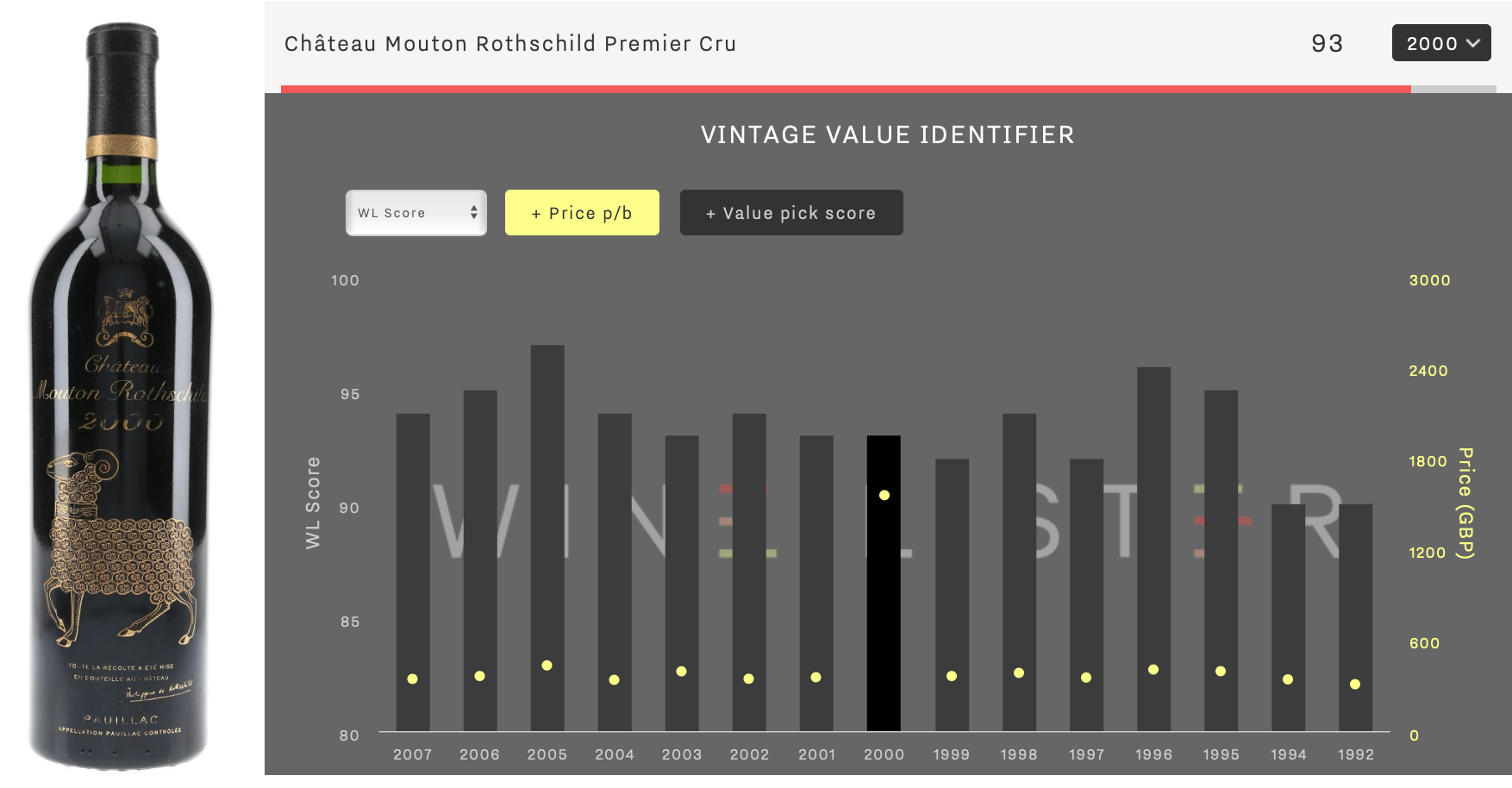
Similarly, the price of Margaux 2015, whose special bottle features a black label in memory of its winemaker, the late Paul Pontallier, has risen 64% since the commemorative bottling was announced.
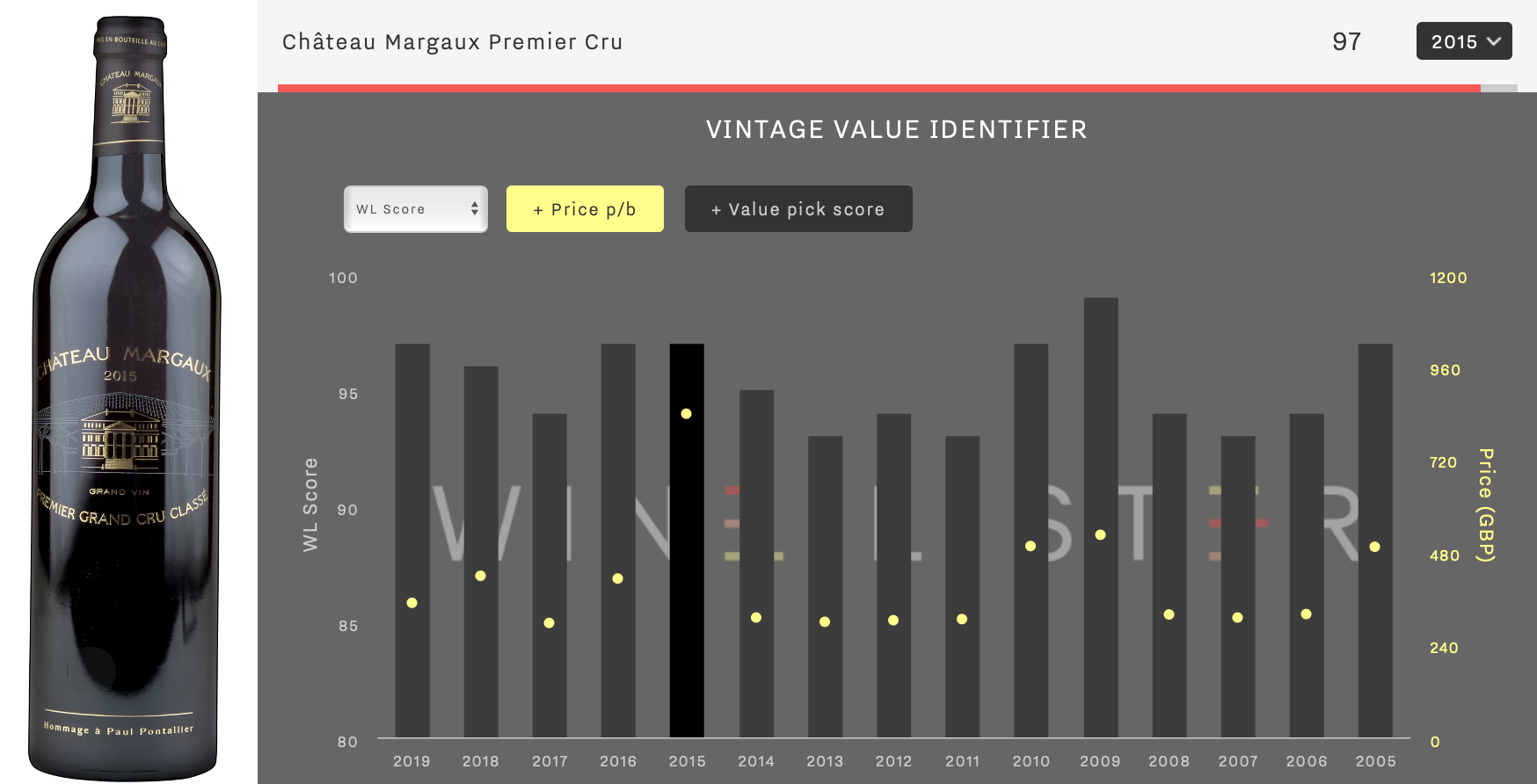
Prices of any remaining Lafite 2018 in the global marketplace are therefore poised to increase between now and the actual bottling of the wine, at which time we understand a small parcel of further, physical stock could be released by the château (presumably at a sizeable premium).
Lafite 2018 is currently an absolute MUST BUY.
*on date of publication, Thursday 17th September 2020
Wine Lister’s latest MUST BUY update identified 38 new wines that show quality and value within their respective vintages and appellations, and wide praise from the international trade. To help you discover these new picks, this week’s blog takes a deep dive into the latest MUST BUY wines and their geographical composition.
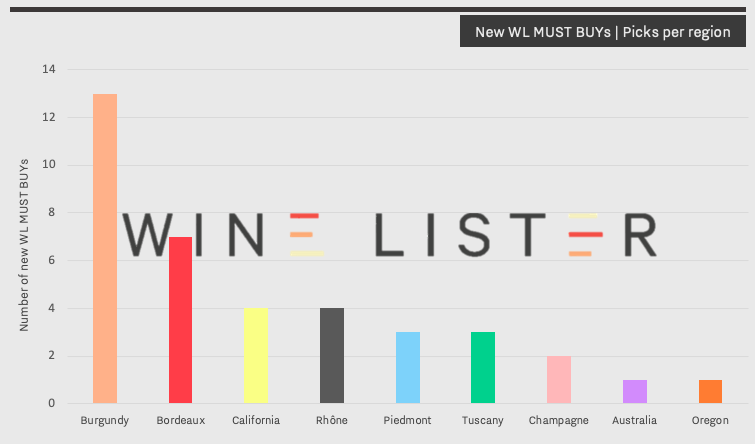
Pinot Noir picks
Burgundy dominates the new MUST BUY hoard with 13 entries, including eight reds. The perfect pick for an opulent occasion, the 1978 Romanée-Conti Richebourg costs £1,434 per bottle (in-bond), and was described by Wine Lister partner critic, Jancis Robinson, as “very long with smoothness, sweetness and unctuousness”. Sharing its WL score of 96, the 2010 Volnay Clos des Ducs from the Côte de Beaune’s red producer of reference, Marquis d’Angerville, provides a more affordable option at £250 per bottle (in-bond), but may merit a little patience.
Outside of Pinot Noir’s original homeland are some new MUST BUYs of brilliant quality and impressive value for money. California’s 2016 Au Bon Climat Isabelle Pinot Noir has a WL score of 94, and was described by Wine Lister partner critic, Antonio Galloni, as “racy, perfumed and beautifully layered”, with notes of “orange peel, tobacco, blood orange, spice, star anise and new oak” throughout. It can be purchased for less than five times the price of the aforementioned Volnay, by the case of six for £262 (in-bond) from Jeroboams.
Travelling north within the US brings us to Oregon’s latest MUST BUY entry – the 2016 Cristom Louise Vineyard Pinot Noir. While more expensive than its Californian counterpart for the same WL score, Cristom’s position as the leading producer in the Willamette Valley, alongside its closer proximity to Burgundy’s cool-climate restrained style, makes it more than worth the c.35% premium. It is available to purchase for c.£60 per bottle (in-bond) from WineBuyers.com.
The best of Bordeaux blends
Bordeaux offers seven new MUST BUYs this week, including two Left Bank Value picks; 2019 Haut-Bages Libéral and 2015 Capbern. With a WL score of 92, the former addition was released en primeur two months ago, and described by James Lawther for JancisRobinson.com as, “busy and expressive on the nose with vineyard-fresh dark fruit, black-olive and mineral notes”. Labelled by Lawther as the “best in recent years”, this gem from Bordeaux’s prominent promotors of biodynamic viticulture, Gonzague and Claire Lurton, has a bright future ahead. It can still be bought en primeur through Justerini & Brooks for £142.50 per six (in-bond).
The 2010 Vieux Château Certan also appears in the latest MUST BUY update, 10 years on from the iconic vintage. It provides a more lavish option for the Bordeaux buyer, receiving a WL score of 96 at £216 per bottle (in-bond). Moving across the border into Tuscany, the 2010 Sassicaia also offers a more luxurious alternative to the Bordeaux blend. Comprising of 85% Cabernet Sauvignon and 15% Cabernet Franc, it was described by Antonio Galloni as, “just beginning to show the first signs of aromatic development”, including hints of “sweet tobacco, mint, pine, dried cherries and licorice”. It achieves a WL score of 95, and is available to purchase by the case of six for £915 from Goedhuis & Co.
Choosing Chardonnay
Back to Burgundy, and the new white MUST BUYs this week offer opulence from three iconic Meursault producers; 2015 Roulot Charmes, 2010 Comtes Lafon Genevrières, and 2017 Arnaud Ente Les Petits Charrons are all exceptional choices, albeit for an average price of £492 per bottle (in-bond). Further north, two entries hail from Chablis, and the appellation’s original historic vineyard, Les Clos; 2014 Laroche Les Clos, and 2010 Christian Moreau Père et Fils Les Clos. For those who enjoy a more pure, lean, and mineral style of white wine, the Chablis MUST BUYs exhibit notable value within their appellation and achieve higher WL scores than their buttery Meursault counterparts. The latter can be bought by the case of 12 from Cru World Wine for £871 (in-bond).
California’s latest white MUST BUY hails from Kistler Vineyard; a cult producer known for its emulation of pure and balanced Burgundian Chardonnays, over the rich and oaky Californian style. The 2017 Kistler Vineyards Dutton Ranch Chardonnay achieves a WL score of 96, and is labelled by Antonio Galloni as “such an intriguing wine because of the way it is airy and lifted and yet also so deep in feel”. Providing a less expensive alternative to Côte d’Or whites, it is priced at £133 per bottle (in-bond).
Also featured in the list of new MUST BUYs are: 2009 Abreu Madrona Ranch Cabernet Sauvignon, 1989 Bollinger Grande Année, 1996 Bruno Clair Chambertin Clos de Bèze, 2006 Cavallotto Barolo Vignolo Riserva, 2013 Ceretto Barolo Brunate, 2012 Conti Costanti Brunello di Montalcino Riserva, 1996 Dunn Vineyards Howell Mountain Cabernet Sauvignon, 2014 Duroché Chambertin Clos de Bèze, 2017 Georges Mugneret-Gibourg Clos de Vougeot, 2012 Jacques-Frédéric Mugnier Chambolle-Musigny Les Amoureuses, 2014 Jean Grivot Richebourg, 2010 Jim Barry The Armagh Shiraz, 2017 Joseph Drouhin Chambolle-Musigny Les Amoureuses, 1996 Lafite Rothschild, 2008 Lafleur, 2016 Le Macchiole Paleo Rosso, 2016 l’Evangile, 2006 Louis Roederer Cristal Rosé, 2018 Marc Sorrel Hermitage, 2013 M. Chapoutier Hermitage Ermitage Blanc De l’Orée, 2016 M. Chapoutier Hermitage Ermitage Le Méal, 2012 Roagna Barbaresco Pajè Vecchie Viti, 2016 Valandraud, and 2009 Vincent Paris Cornas La Geynale.
With so many interesting offers coming in from different merchants, it can be tricky to keep track of what wine you have, let alone where it is, and when it should be drunk. To help you get the most out of your wine collection, Wine Lister has opened up its data analysis and fine wine expertise to private clients, who can now commission all kinds of portfolio analysis, from detailed geographical split and purchase advice, to investment forecasting and a fully-fledged “drink vs. sell” plan.
Wine Lister’s “fantasy cellar”
The current list of Wine Lister MUST BUYs – wines showing notable quality and value within their respective vintages and appellations, and wide praise from the international trade – is 1,728 picks strong. While the Wine Lister team would love to own (and enjoy) all of them, below is a short selection to be put away and enjoyed at their best in five, ten, and twenty years, respectively.
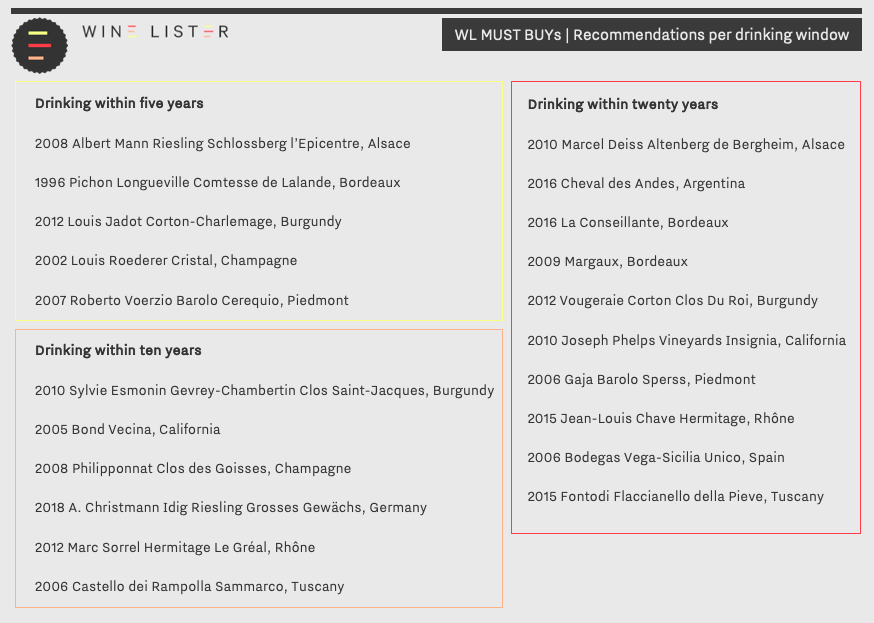
Riesling to reserve
With remarkable ageing potential, and good value across the board, Riesling constitutes a brilliant white addition to any wine collection. To be opened within ten years, the 2018 A. Christmann Idig Riesling Grosses Gewächs hails from Germany’s famed Mosel, and is described by Wine Lister partner critic, Jancis Robinson as “the thinking-person’s Riesling”. She notes the “understatement of individual components” in the wine, “which allows the taster to focus on balance and elegance”. Creeping over the border into the Alsace, where Riesling tends to be drier in style, Albert Mann’s 2008 Schlossberg l’Epicentre is ready but will improve – offering optimum enjoyment within the next five years. Another Alsatian, the 2010 Marcel Deiss Altenberg de Bergheim can endure another 20 years of ageing, also providing a reliable white to add to any cellar. Wine Lister partner critic, Antonio Galloni, describes its “perfumed aromas of nectarine, apple blossom, minerals and honey”, calling it “vibrant and penetrating”. With notable value for their quality, the three Rieslings achieve a shared WL score of 96, at £54, £98, and £59 per bottle (in bond), respectively. For something to stash away, the latter is available by the case of six from Millésima UK.
Burgundy on standby
Louis Jadot Corton Charlemagne 2012 is a similarly reliable white to be stored in the cellar, achieving a WL score of 95 at £126 per bottle (in-bond). Barrel-fermented and aged for a further eight to ten months in 100% new oak barrels, the wine has developed complexity and enhanced ageing potential. Production in 2012 was kept notably small – indeed winemaker Frédéric Barnier states, “it is critical to control the yields in Corton-Charlemagne to make a wine of real Grand Cru quality.” It can be purchased by the case of 12 from Fine+Rare Wines, and can be opened within five years. Burgundy also offers an abundance of reds with promising ageing potential, including the 2010 Sylvie Esmonin Gevrey-Chambertin Clos Saint-Jacques, and the 2012 Vougeraie Corton Clos Du Roi. Both wines achieve a WL score of 95, at £192 and £90 per bottle (in-bond), respectively.
Champagne to store
A sure pick to pop open within five years, the 2002 Louis Roederer Cristal was aged on lees for six years, before being matured for a further eight years in bottle after its disgorgement in 2009. Wine Lister partner critic, Jeannie Cho Lee notes that it is a “gorgeous Cristal with a fine line of acidity running through it – it vibrates on the palate”. With a WL score of 96, at £192 per bottle (in-bond), it is available in cases of three from Vinum Fine Wines. With an identical WL score of 96, the 2008 Philipponnat Clos des Goisses can be acquired by the case of six for £850 (in bond) from Justerini & Brooks, to be enjoyed within the next decade.
New World to wait for
For some New World picks that are worth putting away for the future, Napa Valley offerings include the 2005 Bond Vecina (owned by the famed Harlan family) and the 2010 Joseph Phelps Vineyards Insignia. In regards to the former, Antonio Galloni stated that he would “prefer to cellar it, as the future for this wine is unquestionably very, very bright”. With a WL score of 97, at £347 per bottle (in-bond) it is an opulent option to be enjoyed within the next twenty years. Of the 2010 Joseph Phelps Vineyards Insignia, Galloni states similarly that “the 2010 will enjoy a long drinking window once it softens”. Achieving a WL score of 96, at £158 per bottle (in-bond), it is available in cases of six from Goedhuis & Co.
Also featured in the above MUST BUY recommendations are: 2016 Cheval des Andes, 2016 La Conseillante, 2015 Fontodi Flaccianello della Pieve, 2015 Jean-Louis Chave Hermitage, 2012 Marc Sorrel Hermitage Le Gréal, 2009 Margaux, 2007 Roberto Voerzio Barolo Cerequio, 2006 Bodegas Vega-Sicilia Unico, 2006 Castello dei Rampolla Sammarco, 2006 Gaja Barolo Sperss, and 1996 Pichon Longueville Comtesse de Lalande.
For personalised, impartial fine wine purchase recommendations, as well as further wine collection analysis, get in touch with our team at team@wine-lister.com, or download the full Cellar Analysis information pack.
Thanks to solid discounts on existing market prices from many châteaux, the Bordeaux 2019 en primeur campaign can be considered a success, and may prove in the long-term to have helped the en primeur system find its feet once again, in terms of the cost benefit it offers to buyers.
Part II of Wine Lister’s Bordeaux Study, In sickness, in health discusses this in more detail. In the meantime, below we have selected top MUST BUYs at different price points, to help those still on the hunt for Bordeaux 2019.
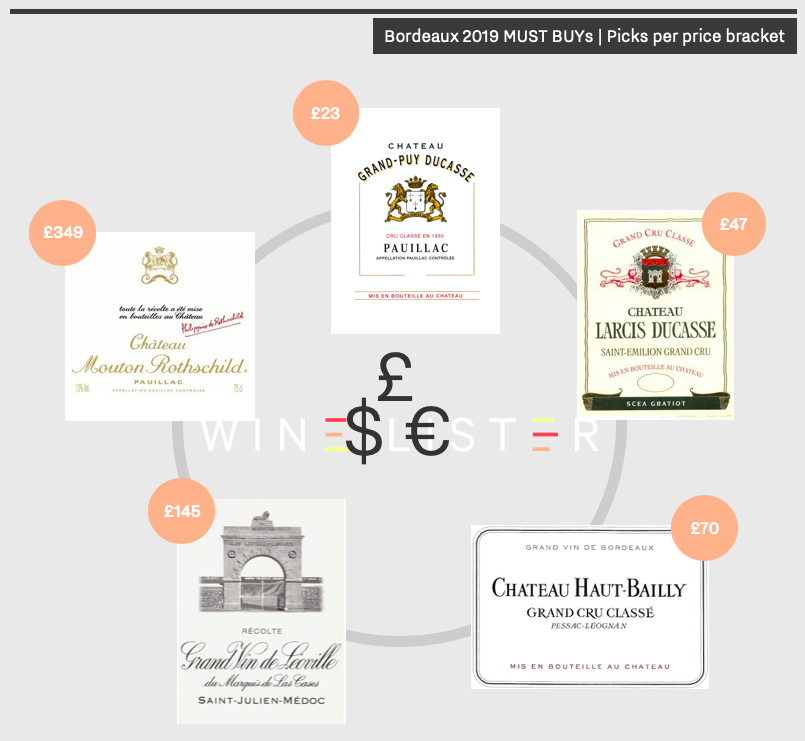
Under £25 – Grand-Puy-Ducasse
Grand-Puy-Ducasse 2019 is both a MUST BUY and a Value Pick, achieving its best ever WL score of 93 in 2019, available at £23 per bottle (in-bond) when buying by the case. The latest release illustrates the contrasting climatic conditions of 2019, with critics noting its complexity and nuance. Wine Lister partner critic, Neal Martin, notes, “crisp tannins, a fine bead of acidity, cohesive and harmonious with a lovely saline/briny note”, adding “this is one of the best Grand Puy Ducasse wines that I have encountered from barrel. Excellent”. Grand-Puy-Ducasse 2019 is available to purchase by the case from Justerini & Brooks.
More Bordeaux 2019 MUSY BUYs under £25: Capbern, Gloria, Laroque, Meyney, Potensac, and Siran.
Under £50 – Larcis-Ducasse
At £47 per bottle (in-bond), Larcis-Ducasse 2019 is priced notably well within the wider context of Saint-Émilion Grand Cru Classé “B” releases. As examined in a recent en primeur blog, it earns a WL score of 95 – just one point less than the likes of Cheval Blanc and Pavie (costing on average six times less than its Classés “A” neighbours). Winemaker, David Suire, observes that the vintage reflects clearly its limestone terroir, showing floral notes and an overriding minerality. Wine Lister partner critic, Antonio Galloni, concurs, noting “graphite, menthol, licorice, tobacco and cedar notes” in the bouquet, coining it “one of Bordeaux’s most under the radar gems”. While demand for this wine has likely been strong, Larcis-Ducasse 2019 is still available through Millésima’s UK and Hong Kong branches.
More Bordeaux 2019 MUST BUYs under £50: Brane-Cantenac, Giscours, Grand-Puy-Lacoste, La Gaffelière, Malescot Saint-Exupéry, and Pavie-Macquin.
Under £100 – Haut-Bailly
At £70 per bottle (in-bond), Haut-Bailly 2019 shares the château’s top WL score (95) with recent vintages 2018, 2016, 2015, and 2014. Managing Director, Veronique Sanders, told the Wine Lister team of their need to light fires five times to prevent frost in the spring of 2019, escaping unscathed. In the end, challenges throughout the growing season concluded in perfect harvest conditions, and a wine of impressive balance and energy. Indeed, the 2019 has received unanimous confidence from critics – Neal Martin states that the 2019 is a “more terroir expressive Haut-Bailly that has an effortless allure and a sense of sophistication”, concluding that it is “wonderful”. Haut-Bailly 2019 can be acquired by the case through Goedhuis & co.
More Bordeaux 2019 MUST BUYs under £100: Calon Ségur, Canon-la-Gaffelière, Canon, Clinet, Léoville Poyferré, Pontet-Canet, Lynch-Bages, Montrose, and Troplong-Mondot.
Under £200 – Léoville Las Cases
Léoville Las Cases 2019 achieves a WL score of 97, at £145 per bottle (in-bond). While volumes of the 2019 released onto the market were down 35% on last year, there is still some availability of this Saint-Julien super second, and we highly recommend getting your hands on some. Wine Lister’s CEO, Ella, describes it as “luminous and lyrical”, noting a bouquet of “English garden – raspberry blossom, cow parsley, fraises de bois, and then a deeper note of ripe cherries”. James Lawther for JancisRobinson.com is similarly impressed, awarding it 19 points and noting it as “one of the greats from this estate”. The latest vintage can be purchased through Fine+Rare.
More Bordeaux 2019 MUST BUYs under £200: Figeac, Haut-Brion, La Conseillante, La Mondotte, Le Petit Mouton, La Mission Haut-Brion, Palmer, Pichon Comtesse, and Vieux Château Certan.
Over £300 – Mouton
While the release price of this Pauillac Premier Cru, let alone the quality of its 2019, likely makes it one of the most popular buys of the campaign, there may still be opportunities to secure some en primeur. Released at £299 per bottle (in-bond), Mouton 2019 achieves a WL score of 97 – the second-highest score achieved by the château in recent years, following the 2016’s 98. Wine Lister’s CEO, Ella Lister, describes Mouton 2019 thus: “velveteen tannins, long and caressing”, recounting “complex, savoury flavours of graphite and slate intermingled with the generous fruit”. Farr Vintners still appears to have some availability of Mouton 2019 (albeit at a slightly higher price than its release).
More Bordeaux 2019 MUST BUYs over £300: Cheval Blanc, Lafite, and Lafleur.
French readers can find this blog in French translation on Le Figaro Vin’s website.
Wine Lister Pro members can read Part II of the Bordeaux study here. All free users can purchase the report for £125 from Wine Lister’s Analysis page (available in both English and French).
This week, Wine Lister published Part II of its annual in-depth Bordeaux Study, In sickness, in health, which, among other inquiries, examines the 40 top-quality crus in 2019. As illustrated in the study, tastings have so far indicated high quality levels across the board in 2019, while numerous wines have made significant advancements, shaking up this year’s rankings.
Following this line of investigation, below we examine the top 25 Bordeaux 2019s by WL score (as separated by mere decimals), and consider the biggest movers since last year. These scores are informed by the recently-released ratings of Wine Lister partner critics, Bettane+Desseauve, Antonio Galloni and Neal Martin for Vinous.com, and James Lawther for JancisRobinson.com.
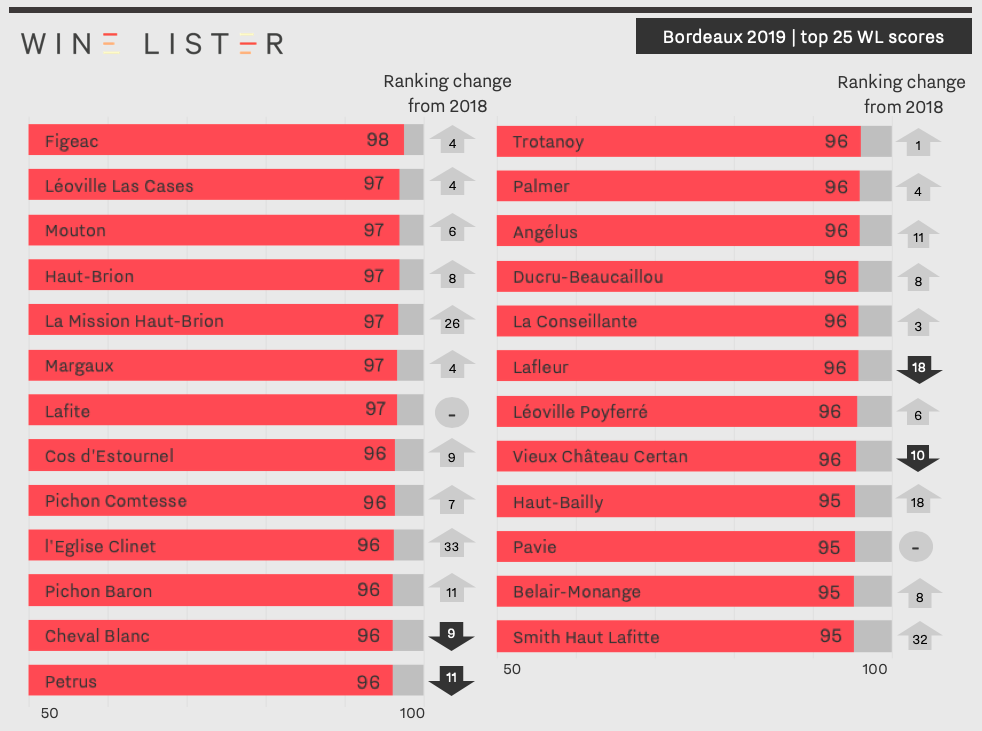
Consistent with last year’s ranking of Bordeaux 2018s by Quality score (conducted before the introduction of Wine Lister’s free site, featuring WL scores out of 100), Pomerol earns the highest number of places (six) in the top 25 2019s by WL score. Neighbouring Saint-Emilion follows closely behind with five spots in this year’s ranking, including the top-scoring wine of the vintage, Figeac 2019, which achieves a WL score of 98.
The four first growths to release their 2019s en primeur appear in third through seventh places, intersected by La Mission Haut-Brion’s entry at fifth place. This promising Pessac-Léognan climbs an impressive 26 spots in 2019, and, as mentioned in our previous blog, has been recently assigned MUST BUY status. Neal Martin scores La Mission Haut-Brion 2019 98-100 points, declaring: “I wager that ultimately this will become one of the wines of the vintage”, concluding that the wine is “breathtaking”.
L’Eglise Clinet sees an impressive upwards shift of 33 places this year, entering the top 10 with a WL score of 96. A poignant tribute to its late winemaker, Denis Durantou, its 2019 has received significant praise, with Antonio Galloni noting that it is “very clearly one of the wines of the year. A Pomerol of soaring, majestic intensity, L’Eglise-Clinet dazzles from start to finish”.
Pichon-Baron and Angélus both climb eleven places in this year’s top-25 ranking, to 11th and 16th place, respectively, with the former receiving top scores from both Neal Martin and Antonio Galloni. Both critics allude to the depth of Pichon-Baron’s 2019, with Galloni stating that “pomegranate, chocolate, licorice and spice are all lavishly expressed”. This represents one of Pauillac’s four entries on this year’s top-25 ranking, which also comprises Mouton, Lafite, and Pichon Comtesse.
Haut-Bailly makes a sizeable leap of 18 places since last year, ranking in 21st place with a WL score of 95. At £70 per bottle (in-bond) Haut-Bailly 2019 is also a Wine Lister MUST BUY. Fellow Pessac-Léognan producer, Smith Haut Lafitte, climbs an impressive 32 places with its 2019 vintage, rounding out the top 25 list. Having tasted twice, Neal Martin describes its “intense, very pure bouquet with blackberry, briary and cherry compote and a hint of black olive tapenade in the background”.
Also featured in the top 25 Bordeaux 2019s by WL score are: Belair-Monange, Cheval Blanc, Cos d’Estournel, Ducru-Beaucaillou, Haut-Brion, La Conseillante, Lafleur, Léoville Las Cases, Léoville Poyferré, Margaux, Palmer, Pavie, Petrus, Trotanoy, and Vieux Château Certan.
Wine Lister Pro members can read Part II of the Bordeaux study here. All free users can purchase the report for £125 from Wine Lister’s Analysis page (available in both English and French).
With the Bordeaux 2019 en primeur campaign now concluded, we bring you 38 new Wine Lister MUST BUYs. The tasting of Bordeaux 2019 has thus far confirmed the notable quality of the vintage, from which we have filtered some obvious campaign buys that can be expected to see increased prices, and decreased availability in the future.
Wine Lister’s MUST BUY recommendation algorithm takes into account a wine’s quality and value within its vintage and appellation, as well as the latest industry intelligence from key players in the global fine wine trade. These results are then filtered through an intelligence-based, human overlay, which identifies MUST BUY wines based on our tasting of Bordeaux 2019, and observation of the reception of each release in the market.
As illustrated below, there are 38 Bordeaux 2019s that are now recognised as MUST BUYs – suggesting that the benefit of buying en primeur is more obvious than last year (there were 24 Bordeaux 2018 en primeurs recognised as MUST BUYs following its campaign). They are all red:
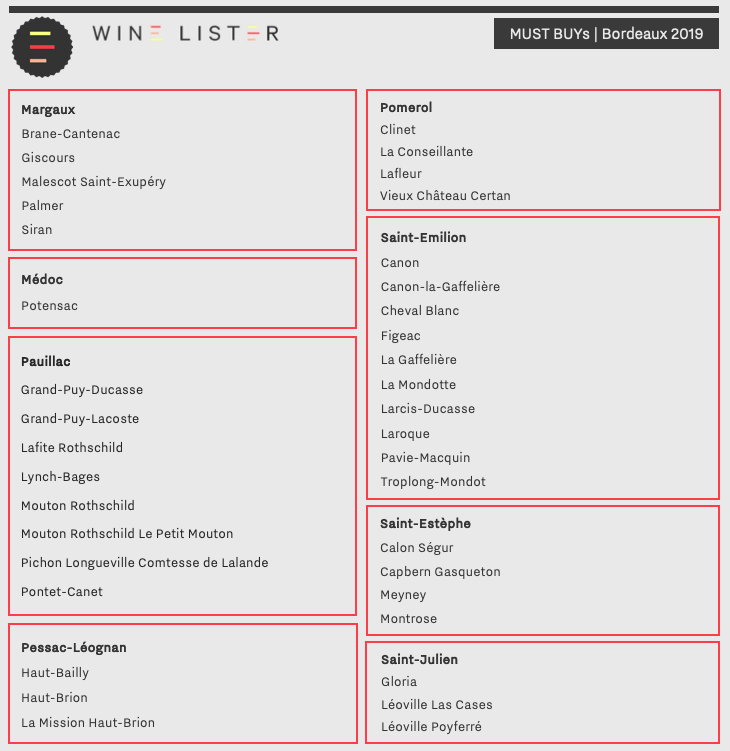
In keeping with last year’s MUST BUY picks, Saint-Emilion once again ranks as the most recommended appellation – this year offering 10 MUST BUYs, including the top-scoring wine of the vintage: Figeac 2019. With a WL score of 98, Figeac’s latest vintage has sustained the château’s upward quality trajectory.
With a WL score of 93 at £18 per bottle (in-bond), Laroque 2019 exhibits excellent value relative to 2019 Saint-Emilions of comparable quality. Alongside its MUST BUY status, Laroque’s latest vintage is also a Value Pick, making it an essential acquisition for the savvy Bordeaux buyer. Wine Lister partner critic, Antonio Galloni, notes, “raspberry jam, spice and red plum meld into the juicy finish”, stating that “the 2019 is very nicely done”.
Pauillac houses eight Bordeaux 2019 MUST BUYs, including first growths Lafite and Mouton, which both achieve WL scores of 97. Grand-Puy-Ducasse 2019 is both a MUST BUY and a Value Pick, having achieved a WL score of 93 at £23 per bottle (in-bond). Writing for Jancisrobinson.com, James Lawther muses whether the 2019 is the, “best of recent vintages?”, suggesting that it “certainly has more structure and power with additional mid-palate flesh”. As proposed in a previous Bordeaux 2019 en primeur blog, Pichon Comtesse is another notable Pauillac purchase for wine collectors, given the estate’s impressive popularity, and its vast reduction in volume released this year.
Within its five MUST BUY picks (four at under £50 per bottle in-bond), Margaux contains two Value Picks, with Malescot Saint-Exupery and Siran priced at £31 and £20 per bottle (in-bond), respectively. At £167 per bottle (in-bond) Palmer 2019 shows good value within the context of its previous vintages (31% below the 2018 and 2016 release prices), which, alongside its limited quantity released en primeur, makes this a must for Margaux enthusiasts.
In Pomerol, La Conseillante, Lafleur, and Vieux Château Certan achieve WL scores of 96, while Clinet follows shortly behind with 95. At £54 per bottle (in-bond) the latter is notably cheaper than its Pomerol peers, and has made a major leap up in quality from previous vintages. Awarding it 97-99 points, Neal Martin writes that Clinet 2019 “is just so fragrant on the nose”, stating that, “the purity that Ronan Laborde and his team have achieved should be applauded”.
Calon Ségur and Montrose lead Saint-Estèphe’s four MUST BUYs with a shared WL score of 95, while Meyney and Capbern provide testament to the value proposition available in the appellation, having been priced at £19 and £15 per bottle (in-bond), respectively.
Sharing three picks apiece are further left bank appellations Saint-Julien and Pessac-Léognan, which are both home to high-scoring 2019s. In Saint-Julien, Léoville Las Cases achieves a WL score of 97 – matched by Pessac-Léognan first growth Haut-Brion, and neighbour, La Mission.
Other wines featured in Wine Lister’s Bordeaux 2019 MUST BUYs are: Brane-Cantenac, Canon, Canon-la-Gaffelière, Cheval Blanc, Giscours, Gloria, Grand-Puy-Lacoste, Haut-Bailly, Le Petit Mouton, La Gaffelière, La Mondotte, Larcis-Ducasse, Léoville Poyferré, Lynch-Bages, Pavie-Macquin, Pontet-Canet, Potensac, and Troplong-Mondot.
Wine Lister has now released Part II of its annual in-depth Bordeaux Study, examining the price and quality of Bordeaux 2019, relative to previous vintages. Purchase the full report here, or download using your Pro subscription (available in both English and French).
Despite wide speculation over whether an en primeur campaign could proceed at all in 2020, this year’s campaign is now more or less complete, and Wine Lister’s scores are in. Bordeaux 2019s exhibit high quality across the board, receiving frequent comparison with recent great vintages – 2016, 2015, 2010, and 2009.
Wine Lister has now published its latest Wine Leagues on the new vintage – examining which Bordeaux 2019s rank best for WL score in each major appellation.
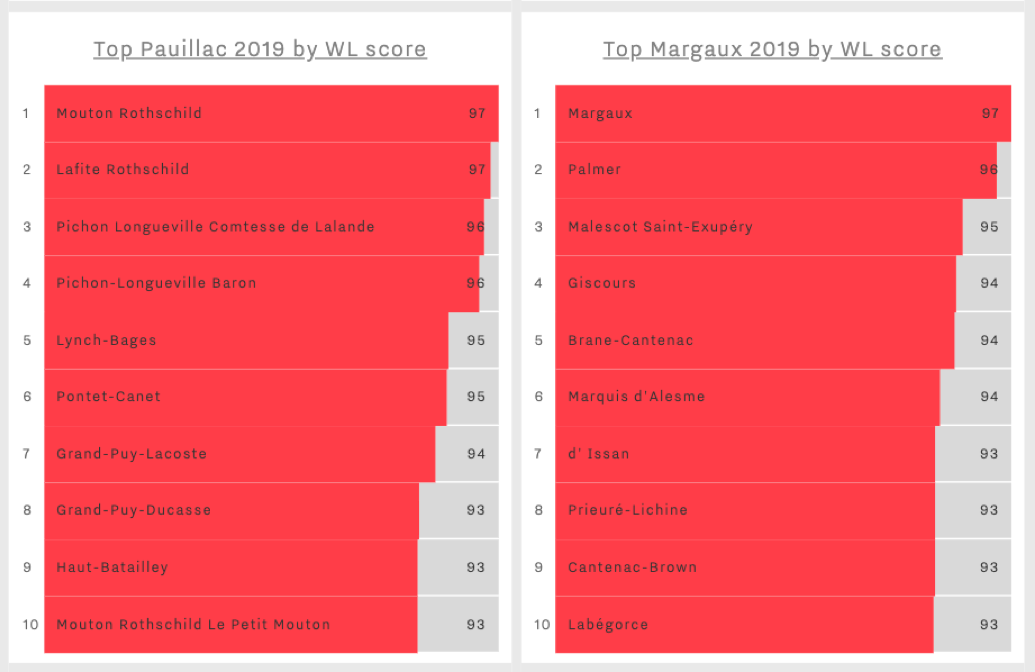
Pauillac First Growths, Lafite and Mouton, lead the appellation’s league of top 2019s by WL score, with a joint score of 97. Pichon Comtesse and Pichon Baron follow suit with 96 – the latter achieving its highest WL score since its 2016 vintage. Wine Lister partner critic Neal Martin describes Pichon-Baron 2019 as having “a very refined bouquet” and a “silky smooth, creamy texture”, stating it “retains all the classicism you could ask for”.
The league of Margaux 2019s by WL score is topped by the appellation’s namesake property, whose latest release joins fellow Pauillac Firsts with a score of 97. Following Palmer’s entry with 96, Malescot Saint-Exupéry 2019 achieves the château’s highest ever WL score (95). Wine Lister partner critic, Antonio Galloni notes that the 2019 is “a striking wine that is sure to find many admirers”, recounting an “interplay of earthy and savoury notes with rich, dense fruit… utterly captivating”.
There are four Value picks featured in the league of Margaux 2019s by WL score, with Labégorce, Malescot Saint-Exupéry, Marquis d’Alesme, and Prieuré-Lichine all achieving scores of 93 and above, at under £35 per bottle (in-bond).
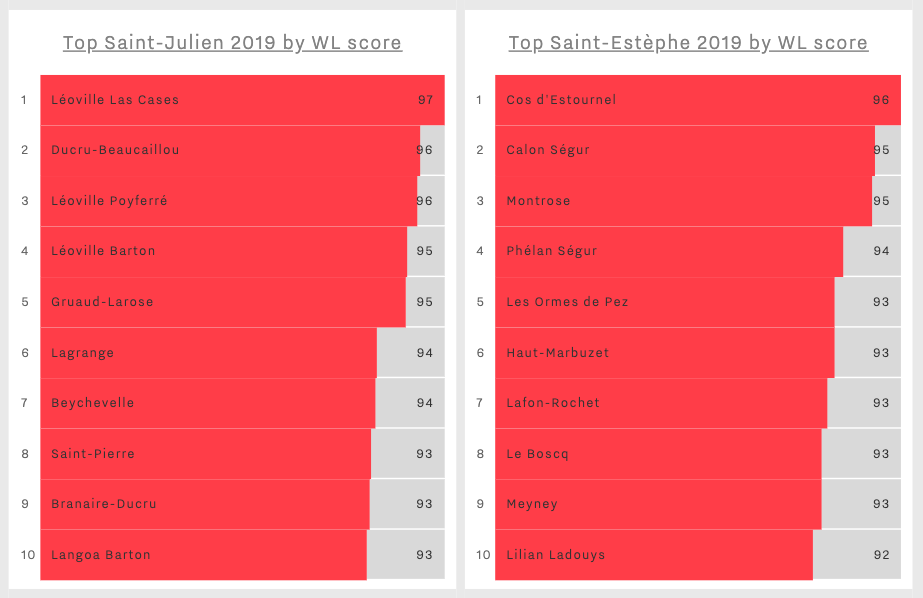
In Saint-Julien, Léoville Las Cases 2019 achieves a WL score of 97, matching that of its 2018 and 2016 vintages. Ducru-Beaucaillou and Léoville Poyferré appear in joint-second place with 96 – achieving their highest WL scores since 2016 and 2015, respectively. Ducru-Beaucaillou 2019 performed notably well at tastings, with Neal Martin, awarding it 96-98 points. He notes its “filigree tannins, pitch perfect acidity and a sensual, satin-like texture”, concluding that the wine is “outstanding in terms of persistence”.
With a score of 96, Cos d’Estournel 2019 tops the league for Saint-Estèphe 2019s by WL score, matching its successful 2018 and 2016 vintages. Writing for JancisRobinson.com, James Lawther describes the vintage as “powerful but carefully constructed and precise”, noting “a lovely mellow quality to such a muscular wine”. While both falling one WL score below their previous vintage, Calon Ségur and Montrose appear second in the appellation’s league, with a shared score of 95.
Branaire-Ducru 2019 and Meyney 2019 exhibit notable value within their appellations – both achieving WL scores of 93 at £29 and £19 per bottle (in-bond), respectively.
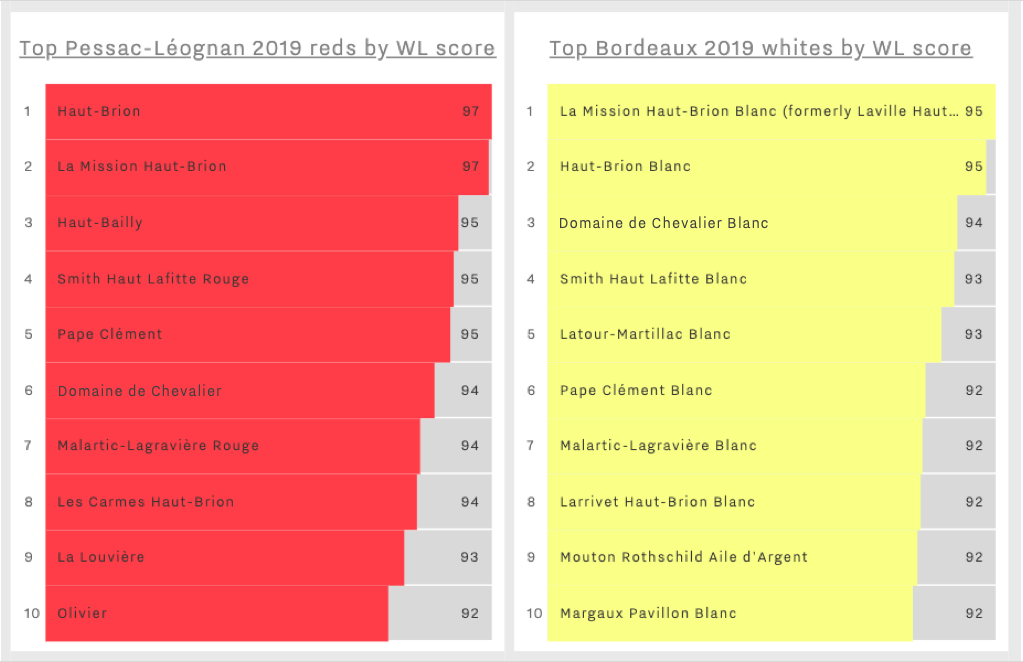
Haut-Brion and La Mission Haut-Brion perform notably well in 2019, achieving joint-first place in the league of top Pessac-Léognan 2019 reds by WL score. As examined in a previous Bordeaux 2019 en primeur blog, the en primeur darling, Les Carmes Haut-Brion, shows clear qualitative success in 2019, and its small production levels and smart en primeur pricing has once again made it a clear campaign buy. Another promising pick from Pessac-Léognan, Olivier 2019 achieves Value pick status at c.£20 per bottle (in-bond), and achieves the château’s highest WL score (92). Antonio Galloni recounts “smoke, licorice, cured meat, graphite and savory herbs infuse the 2019 with striking aromatic intensity to play off its sumptuous fruit”, concluding that the wine is “Very good”.
Haut-Brion and La Mission Haut-Brion attain joint-first place for their whites as well as reds in 2019, achieving scores of 95 in the league of top Bordeaux 2019 whites by WL score. Latour-Martillac Blanc 2019 achieves the highest WL score seen across its vintages (93) – one WL score above Pape Clément Blanc’s 92. At c.£21 per bottle (in bond) Latour-Martillac Blanc 2019 enters the market 10-30% below the current market prices of vintages 2016-2018, showing good value for its quality. Neal Martin notes on the latest vintage: “subtle tropical notes of pineapple and orange rind with hints of strawberry come through on the finish”.
On the right bank, the league of top 10 Saint-Emilion 2019s is crowned by Figeac’s high-scoring 2019. Up one point on its 2018, Figeac’s latest release achieves the highest WL score of all Bordeaux 2019s (98). Figeac 2019 illustrates the château’s impressive upward quality trajectory, which has seen its WL score slowly but surely increase from 91 in 2008. Neal Martin gives the latest vintage 97-99 points, describing it as “exquisitely defined… a deeply impressive, intellectual Figeac”.
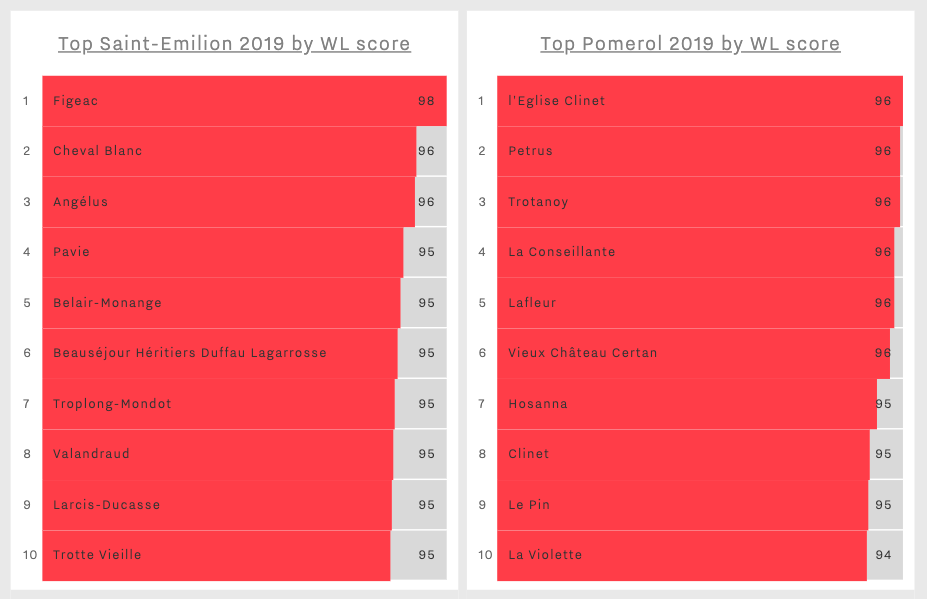
La Conseillante, Lafleur, l’Eglise Clinet, Petrus, Trotanoy, and Vieux Château Certan share the top WL score of Pomerol 2019s (96), separated by mere decimals. A release of note, l’Eglise Clinet 2019 is the last vintage of the late Denis Durantou, who sadly passed away in May. Neal Martin’s impressive score of 97-99 suggests the last vintage was his best, adding, “the perfect way to remember and raise a toast to one of Pomerol’s finest vignerons”.
Click here to view all Wine Leagues. Pro users have access to a more extensive set of Leagues and can log in to access here.
Part I of Wine Lister’s annual in-depth Bordeaux report: For better, for worse, examines the state of the market for Bordeaux wines, in the context of 2019 en primeur.
As well as providing insight into the wine trade’s latest position on key wines of the region, the study examines Bordeaux’s disconnect between consumer popularity and its market performance at the start of 2020 (exacerbated by recent macro-economic hits to the UK, Hong Kong, and the US).
As illustrated below, Bordeaux has achieved the slowest price growth on the secondary market since May 2014, while Piedmont has seen the most impressive growth – likely due to increasing attention given to the region, and the rarity factor of many of its top wines, from which Burgundy also benefits.
 The price performance of Bordeaux compared to four other key fine wine regions: Burgundy, California, Piedmont, and Tuscany. The price indices comprise the top five wine brands in each respective region.
The price performance of Bordeaux compared to four other key fine wine regions: Burgundy, California, Piedmont, and Tuscany. The price indices comprise the top five wine brands in each respective region.
A glance at its price performance since May 2019 tells a similar, if more unnerving story – Bordeaux has floundered over the past year, down nearly 5%.
Despite its price performance difficulties, Bordeaux nonetheless continues its legacy as the most popular wine region by a large margin, based on monthly searches made on Wine-Searcher.
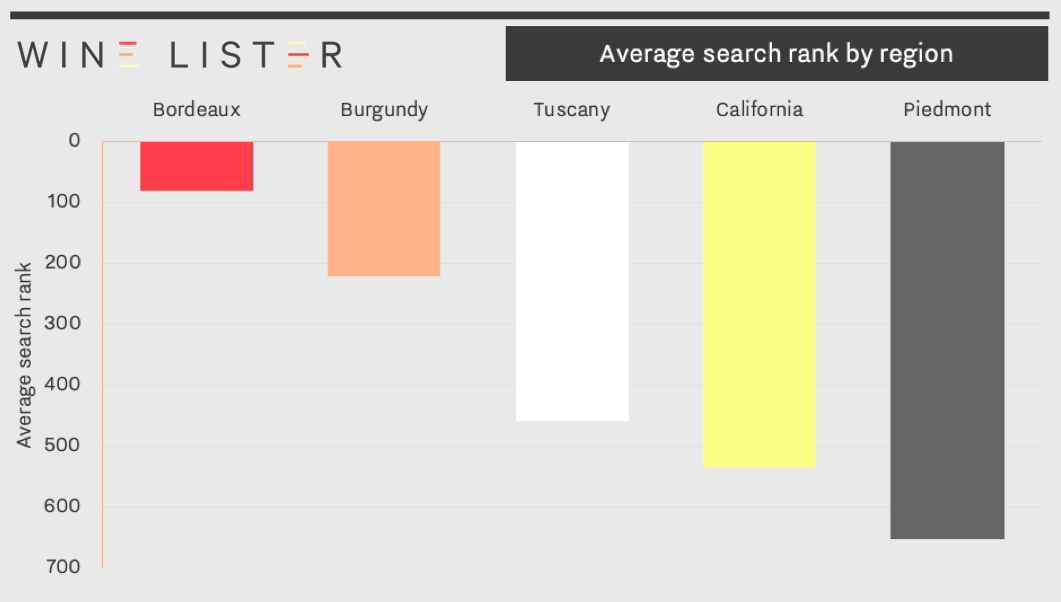 The average search rank of Bordeaux compared to four other key fine wine regions: Burgundy, California, Piedmont, and Tuscany. Results are based on the average searches on Wine-Searcher for the 50 top-scoring wines per region over the last year.
The average search rank of Bordeaux compared to four other key fine wine regions: Burgundy, California, Piedmont, and Tuscany. Results are based on the average searches on Wine-Searcher for the 50 top-scoring wines per region over the last year.
Irrespective of its price performance struggles, Bordeaux remains a focus of fine wine buyers – within the trade and beyond – all over the world. The en primeur campaign is a wheel that just keeps on turning, even in spite of a global pandemic. Trade and consumers alike can’t help but back Bordeaux, for richer and poorer.
More insight into the success of the 2019 en primeur campaign will be included in Part II of this study. In the meantime, visit the Analysis page to purchase Part I, or download using your Pro subscription (available in both English and French).

 Photo credit: lvmh.com
Photo credit: lvmh.com A line-up of Bond wines, that communicate the differences in the estate’s Napa Valley sites.
A line-up of Bond wines, that communicate the differences in the estate’s Napa Valley sites. Photo credit: ornellaia.com
Photo credit: ornellaia.com











